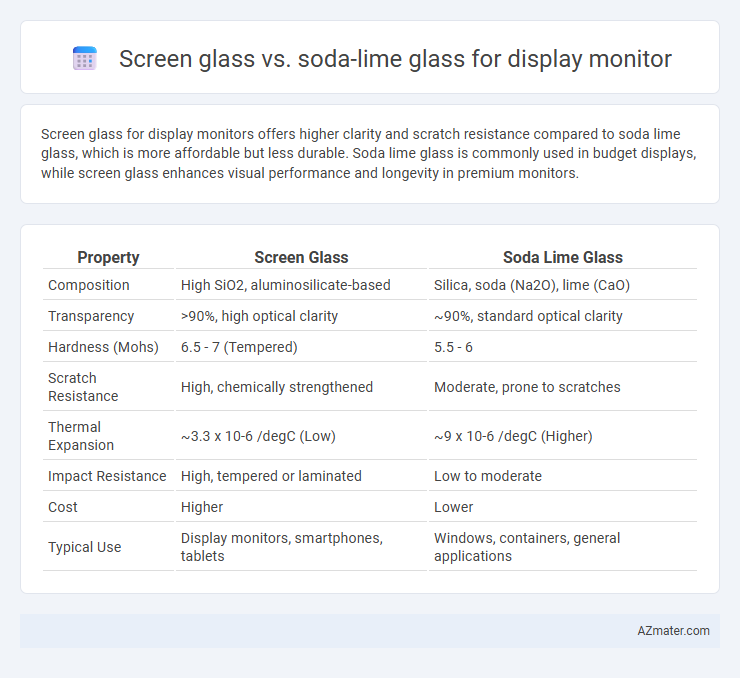Screen glass for display monitors offers higher clarity and scratch resistance compared to soda lime glass, which is more affordable but less durable. Soda lime glass is commonly used in budget displays, while screen glass enhances visual performance and longevity in premium monitors.
Table of Comparison
| Property | Screen Glass | Soda Lime Glass |
|---|---|---|
| Composition | High SiO2, aluminosilicate-based | Silica, soda (Na2O), lime (CaO) |
| Transparency | >90%, high optical clarity | ~90%, standard optical clarity |
| Hardness (Mohs) | 6.5 - 7 (Tempered) | 5.5 - 6 |
| Scratch Resistance | High, chemically strengthened | Moderate, prone to scratches |
| Thermal Expansion | ~3.3 x 10-6 /degC (Low) | ~9 x 10-6 /degC (Higher) |
| Impact Resistance | High, tempered or laminated | Low to moderate |
| Cost | Higher | Lower |
| Typical Use | Display monitors, smartphones, tablets | Windows, containers, general applications |
Introduction to Screen Glass and Soda Lime Glass
Screen glass for display monitors is engineered to provide high transparency, durability, and scratch resistance, often incorporating treatments like anti-reflective coatings for enhanced visual clarity. Soda lime glass, the most common glass type, is composed primarily of silica, soda, and lime, offering cost-effective manufacturing but lower durability and optical performance compared to specialized screen glass. The selection between screen glass and soda lime glass impacts display quality, longevity, and user experience due to differences in optical properties and resistance to environmental factors.
Composition Differences: Screen Glass vs Soda Lime Glass
Screen glass used in display monitors typically contains higher amounts of aluminosilicate or borosilicate compounds, offering enhanced strength, scratch resistance, and thermal stability compared to soda lime glass. Soda lime glass, composed mainly of silica (SiO2), soda (Na2O), and lime (CaO), has lower durability and is more prone to scratching and thermal stress. The differing chemical compositions directly influence their mechanical properties, with screen glass engineered for the rigorous demands of electronic displays.
Optical Clarity and Light Transmission
Screen glass for display monitors typically offers superior optical clarity with higher light transmission rates compared to soda lime glass, ensuring sharper images and more vibrant colors. The specialized coatings on screen glass reduce reflections and glare, enhancing visual performance in various lighting conditions. In contrast, soda lime glass has lower purity and more impurities, resulting in reduced light transmission and less precise image quality.
Mechanical Strength and Durability Comparison
Screen glass, typically made from aluminosilicate or tempered glass, offers superior mechanical strength and scratch resistance compared to soda lime glass, making it more suitable for display monitors subjected to frequent touch and impact. Soda lime glass, while cost-effective and widely used, has lower durability and is more prone to cracking or breaking under stress or drop impacts. The enhanced toughness and flexibility of screen glass improve the overall lifespan and safety of monitors in both consumer electronics and industrial applications.
Scratch and Impact Resistance
Screen glass typically features enhanced scratch resistance due to its chemical strengthening process, such as ion exchange, which creates a compressive surface layer that protects against abrasions. Soda lime glass, commonly used in lower-cost displays, offers less impact resistance and is more prone to surface scratches due to its softer composition and lower durability. For high-performance display monitors, chemically strengthened glass like Gorilla Glass outperforms soda lime glass in both scratch and impact resistance, ensuring longer-lasting screen integrity in daily use.
Display Performance: Color and Brightness
Screen glass used in display monitors typically offers superior optical clarity and enhanced light transmittance compared to soda lime glass, resulting in more vivid colors and higher brightness levels. Its advanced coatings reduce reflections and improve contrast ratios, which enhances color accuracy and overall visual performance. Soda lime glass, being less optimized for optical applications, tends to diffuse light more and offer lower color fidelity, making it less suitable for high-end display monitors.
Surface Treatments and Coatings
Screen glass for display monitors often features advanced surface treatments like anti-reflective (AR) coatings, oleophobic layers, and scratch-resistant hard coatings, enhancing visual clarity and durability. Soda lime glass, commonly used as a baseline material, usually lacks such specialized coatings and is more prone to glare, fingerprints, and surface damage. The application of multi-layer AR coatings on screen glass significantly improves light transmission and reduces reflections, making it the preferred choice for high-performance display monitors.
Cost Considerations for Manufacturers
Screen glass used in display monitors typically incurs higher production costs compared to soda lime glass due to specialized treatments like anti-reflective coatings and enhanced durability features. Soda lime glass offers a cost-effective alternative, benefiting from large-scale manufacturing and lower raw material expenses, but it may lack the advanced optical clarity and scratch resistance required for premium displays. Manufacturers must balance these factors, often opting for screen glass in high-end products while choosing soda lime glass for budget-friendly monitors to optimize overall production costs.
Environmental Impact and Recycling
Screen glass, often made from aluminosilicate or specialized optical glasses, offers higher durability and better scratch resistance compared to soda lime glass commonly used in display monitors. Soda lime glass has a simpler composition, making it easier and more cost-effective to recycle, but it typically demands more energy and resources during production, increasing its environmental footprint. Choosing screen glass reduces the frequency of replacements, lowering waste generation, while soda lime glass benefits from established recycling infrastructure that can reduce landfill contributions and save raw materials.
Choosing the Right Glass for Display Monitors
Screen glass offers superior scratch resistance and optical clarity compared to soda lime glass, making it ideal for high-resolution display monitors that demand durability and precise visuals. Soda lime glass, while more cost-effective and widely used in general applications, lacks the advanced hardness and anti-reflective properties required for premium display performance. Selecting screen glass enhances user experience by reducing glare and maintaining screen integrity over time, ensuring optimal functionality and longevity of display monitors.

Infographic: Screen glass vs Soda lime glass for Display monitor
 azmater.com
azmater.com